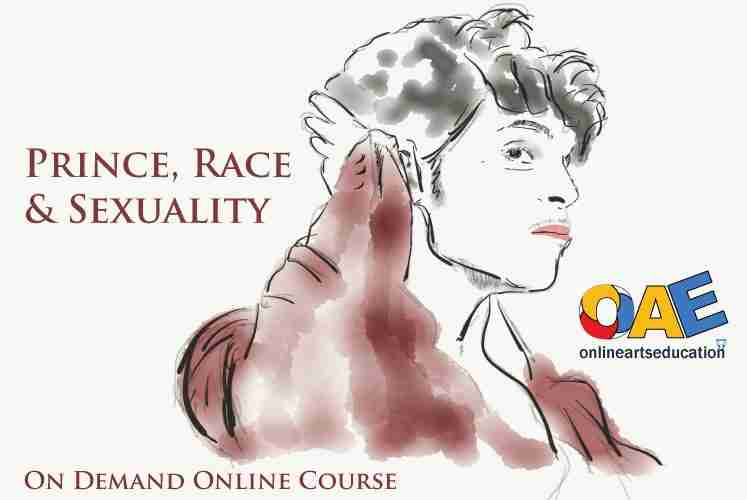This course looks into the race (ethnicity), gender and sexuality of Prince’s persona and his art. Prince showed us non-conformist self-expression. He created a persona that showed us to be free, and not only as artists, but everyone can create or design his/her own life. Finally, and most importantly, he showed us the flawed premise of the dichotomy between black and white, male and female, and homosexuality and heterosexuality.
This course in 20 words: Innovative, Fresh, Unique, Exploratory, Fun, Engaging, Special, Searching, Creative, Prince, Rewarding, Inspiring, Adaptable, Illuminating, Race, Sexuality, Artistry, Range, New, Perspectives
Personal introduction to the course by course creator and facilitator Karin Merx
Course Overview
- 6 lessons of study
- Self-directed viewing & note-taking
- Certificate of Completion
- English
Handcrafted Course Delivery
- Tutorial Videos, Articles & More…
- Handcrafted guides and prompt questions
- Optional extended sources for advanced learners
Who is this course for?
- You!
- Students & Teachers
- Lifelong Learners
- Academics & Researchers
About the Course
Prince Roger Nelson (1958-2016) was an international star who is known for his multi-instrumental talent and his provocative style. He toured about 29 times, released 30+ albums, directed 3, and acted in 4 feature films. However, despite his fame and immense artistic output on which has been written a few books, several questions remain……..
- Who was Prince?
- How and why did he show us his ‘provocative’ persona and art?
- What does Prince and his art mean to us now?
We begin with an introduction of the terminology used in this course and give the historical context. Then we consider Prince’s early career as musician by analyzing the three album covers of his first records. We will proceed through Prince’s artistic canon of the eighties and beginning of the nineties, visiting key works of art and the context in which they were created. By the end, it is my wish that we have a more clearer sense and idea of the cultural significance of the artist Prince.
 Karin Merx MA, Course Creator and Facilitator
Karin Merx MA, Course Creator and Facilitator
Karin Merx is Master of Arts in Cultural Studies, and she is a classically trained musician. She spent 20 + years teaching music, and enjoys teaching about the subjects she loves. Karin is visual artist and enjoys illustrating books and book covers. Her research interests are popular culture, cultural philosophy, music, and art history. She is a professional academic, artist, editor and podcaster.
Karin has the following qualifications:
- MA Cultural Studies (Art History, Cultural History, Cultural Philosophy, Literature), specialised in Art History, achieved in 2012 from Open University Netherlands.
- BA Cultural Studies – Cultural Philosophy achieved in 2009 from Open University Netherlands.
- BMus Sweelinck Conservatorium Amsterdam (flute).
Disclaimer
My books, courses and resources are designed to help you reach your full potential and improve your life experience. As the law states, I cannot and do not make any guarantees about your ability to get results with my ideas, information, tools or strategies. All products and services by Karin Merx Arts, karinmerx.co.uk, MichaelJacksonStudies.org and OnlineArtsEducation.co.uk are for educational and informational purposes only. Nothing in this work, any of these websites, or any of this content or curriculum is a promise or guarantee of specific results.
Course Instructor
One-Time Payment
Prince, Race & Sexuality
In this introduction we gain an understanding of the terminology (ethnicity, gender and sexuality) and history of the seventies and the eighties of America to put Prince in the context of his time. This lesson also gives you the resources, needed for this course.
In this lesson we take a look at the first 3 album covers Prince: For You 1978, Prince 1979 and Dirty Mind 1980. These covers show the direction Prince took in the beginning of his career. By analysing these covers we learn how Prince thought about race, gender and sexuality.
In this lesson we look into Dandyism, its origins, and explore Prince’s outfit, hair, face, gestures. By placing his persona in a historical context, we also look into the message he was conveying.
This week is about the lyrics of several songs of Prince. His explicit, sometimes almost pornographic texts, were reason to form ‘The Washington Wifes’. We take a closer look at the texts, the metaphors, the way Prince is playing with gender fluidity, and images of performances where Prince provocatively pushed against boundaries.
In this lesson we look into the use of voice in relation to race, gender and sexuality, and take a closer look at the ‘Love sign’ Prince used since the nineties and the meaning of it.
In this last session you can choose to create an Prince like piece (music or cover) that expresses the way you see Race (Ethnicity), Gender and Sexuality now, or make a video essay on one of the questions.



